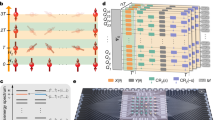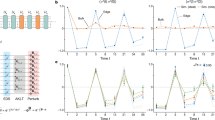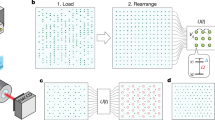Abstract
Quantum phase transitions (QPTs) involve transformations between different states of matter that are driven by quantum fluctuations1. These fluctuations play a dominant part in the quantum critical region surrounding the transition point, where the dynamics is governed by the universal properties associated with the QPT. Although time-dependent phenomena associated with classical, thermally driven phase transitions have been extensively studied in systems ranging from the early Universe to Bose–Einstein condensates2,3,4,5, understanding critical real-time dynamics in isolated, non-equilibrium quantum systems remains a challenge6. Here we use a Rydberg atom quantum simulator with programmable interactions to study the quantum critical dynamics associated with several distinct QPTs. By studying the growth of spatial correlations when crossing the QPT, we experimentally verify the quantum Kibble–Zurek mechanism (QKZM)7,8,9 for an Ising-type QPT, explore scaling universality and observe corrections beyond QKZM predictions. This approach is subsequently used to measure the critical exponents associated with chiral clock models10,11, providing new insights into exotic systems that were not previously understood and opening the door to precision studies of critical phenomena, simulations of lattice gauge theories12,13 and applications to quantum optimization14,15.
This is a preview of subscription content, access via your institution
Access options
Access Nature and 54 other Nature Portfolio journals
Get Nature+, our best-value online-access subscription
$29.99 / 30 days
cancel any time
Subscribe to this journal
Receive 51 print issues and online access
$199.00 per year
only $3.90 per issue
Buy this article
- Purchase on Springer Link
- Instant access to full article PDF
Prices may be subject to local taxes which are calculated during checkout




Similar content being viewed by others
Data availability
The data that support the findings of this study are available from the corresponding author on reasonable request.
References
Sachdev, S. Quantum Phase Transitions 2nd edn (Cambridge Univ. Press, Cambridge, 2009).
Kibble, T. W. B. Topology of cosmic domains and strings. J. Phys. Math. Gen. 9, 1387–1398 (1976).
Zurek, W. H. Cosmological experiments in superfluid helium? Nature 317, 505–508 (1985).
del Campo, A. & Zurek, W. H. Universality of phase transition dynamics: topological defects from symmetry breaking. Int. J. Mod. Phys. A 29, 1430018 (2014).
Navon, N., Gaunt, A. L., Smith, R. P. & Hadzibabic, Z. Critical dynamics of spontaneous symmetry breaking in a homogenous Bose gas. Science 347, 167–170 (2015).
Polkovnikov, A., Sengupta, K., Silva, A. & Vengalattore, M. Nonequilibrium dynamics of closed interacting quantum systems. Rev. Mod. Phys. 83, 863–883 (2011).
Polkovnikov, A. Universal adiabatic dynamics in the vicinity of a quantum critical point. Phys. Rev. B 72, 161201 (2005).
Zurek, W. H., Dorner, U. & Zoller, P. Dynamics of a quantum phase transition. Phys. Rev. Lett. 95, 105701 (2005).
Dziarmaga, J. Dynamics of a quantum phase transition: exact solution of the quantum ising model. Phys. Rev. Lett. 95, 245701 (2005).
Huse, D. A. & Fisher, M. E. Domain walls and the melting of commensurate surface phases. Phys. Rev. Lett. 49, 793–796 (1982).
Ostlund, S. Incommensurate and commensurate phases in asymmetric clock models. Phys. Rev. B 24, 398–405 (1981).
Tagliacozzo, L., Celi, A., Orland, P., Mitchel, M. W. & Lewenstein, M. Simulation of non-Abelian gauge theories with optical lattices. Nat. Commun. 4, 2615 (2013).
Weimer, H., Müller, M., Lesanovsky, I., Zoller, P. & Büchler, H. P. A Rydberg quantum simulator. Nat. Phys. 6, 382–388 (2010).
Farhi, E., Goldstone, J., Gutmann, S. & Spiser, M. Quantum computation by adiabatic evolution. Preprint at https://arxiv.org/abs/quant-ph/0001106 (2000).
Gardas, B., Dziarmaga, J., Zurek, W. H. & Zwolak, M. Defects in quantum computers. Sci. Rep. 8, 4539 (2018).
Anquez, M. et al. Quantum Kibble–Zurek mechanism in a spin-1 Bose–Einstein condensate. Phys. Rev. Lett. 116, 155301 (2016).
Clark, L. W., Feng, L. & Chin, C. Universal space-time scaling symmetry in the dynamics of bosons across a quantum phase transition. Science 354, 606–610 (2016).
Endres, M. et al. The ‘Higgs’ amplitude mode at the two-dimensional superfluid/Mott insulator transition. Nature 487, 454–458 (2012).
Chen, D., White, M., Borries, C. & deMarco, B. Quantum quench of an atomic Mott insulator. Phys. Rev. Lett. 106, 235304 (2011).
Braun, S. et al. Emergence of coherence and the dynamics of quantum phase transitions. Proc. Natl Acad. Sci. 112, 3641–3646 (2015).
Bernien, H. et al. Probing many-body dynamics on a 51-atom quantum simulator. Nature 551, 579–584 (2017).
Kolodrubetz, M., Clark, B. K. & Huse, D. A. Nonequilibrium dynamical critical scaling of the quantum Ising chain. Phys. Rev. Lett. 109, 015701 (2012).
Cherng, R. W. & Levitov, L. S. Entropy and correlation functions of a driven quantum spin chain. Phys. Rev. A 73, 043614 (2006).
Fendley, P., Sengupta, K. & Sachdev, S. Competing density-wave orders in a one-dimensional hard-boson model. Phys. Rev. B 69, 075106 (2004).
Samajdar, R., Choi, S., Pichler, H., Lukin, M. D. & Sachdev, S. Numerical study of the chiral Z3 quantum phase transition in one spatial dimension. Phys. Rev. A 98, 023614 (2018).
Whitsitt, S., Samajdar, R. & Sachdev, S. Quantum field theory for the chiral clock transition in one spatial dimension. Phys. Rev. B 98, 205118 (2018).
Chepiga, N. & Mila, F. Floating phase versus chiral transition in a 1D hard-boson model. Phys. Rev. Lett. 122, 017205 (2019).
Haldane, F. D. M., Bak, P. & Bohr, T. Phase diagrams of surface structures from Bethe-ansatz solutions of the quantum sine-Gordon model. Phys. Rev. B 28, 2743 (1983).
Dutta, A. et al. Quantum Phase Transitions in Transverse Field Spin Models: From Statistical Physics to Quantum Information (Cambridge Univ. Press, Cambridge, 2015).
Moessner, R., Sondhi, S. L. & Fradkin, E. Short-ranged resonating valence bond physics, quantum dimer models, and Ising gauge theories. Phys. Rev. B 65, 024504 (2001).
Barredo, D., Lienhard, V., de Léséleuc, S., Lahaye, T. & Browaeys, A. Synthetic three-dimensional atomic structures assembled atom by atom. Nature 561, 79–82 (2018).
Kumar, A., Wu, T.-Y., Giraldo Mejia, F. & Weiss, D. S. Sorting ultracold atoms in a three-dimensional optical lattice in a realization of Maxwell’s demon. Nature 561, 83–87 (2018).
Pichler, H., Wang, S.-T., Zhou, L., Choi, S. & Lukin, M. D. Quantum optimization for maximum independent set using Rydberg atom arrays. Preprint at https://arxiv.org/abs/1808.10816 (2018).
Endres, M. et al. Atom-by-atom assembly of defect-free one-dimensional cold atom arrays. Science 354, 1024–1027 (2016).
Levine, H. et al. High-fidelity control and entanglement of Rydberg-atom qubits. Phys. Rev. Lett. 121, 123603 (2018).
White, S. R. Density matrix formulation for quantum renormalization groups. Phys. Rev. Lett. 69, 2863–2866 (1992).
White, S. R. Density-matrix algorithms for quantum renormalization groups. Phys. Rev. B 48, 10345–10356 (1993).
Östlund, S. & Rommer, S. Thermodynamic limit of density matrix renormalization. Phys. Rev. Lett. 75, 3537–3540 (1995).
Rommer, S. & Östlund, S. Class of ansatz wave functions for one-dimensional spin systems and their relation to the density matrix renormalization group. Phys. Rev. B 55, 2164–2181 (1997).
Dukelsky, J., Martin-Delgado, M. A., Nishino, T. & Sierra, G. Equivalence of the variational matrix product method and the density matrix renormalization group applied to spin chains. Europhys. Lett. 43, 457–462 (1998).
Peschel, I., Wang, X., Kaulke, M. & Hallberg, K. (eds) Density-Matrix Renormalization (Springer, Berlin, 1999).
McCulloch, I. P. Infinite size density matrix renormalization group, revisited. Preprint at https://arxiv.org/abs/0804.2509 (2008).
Pirvu, B., Murg, V., Cirac, J. I. & Verstraete, F. Matrix product operator representations. New J. Phys. 12, 025012 (2010).
Schollwöck, U. The density-matrix renormalization group. Rev. Mod. Phys. 77, 259–315 (2005).
Schollwöck, U. The density-matrix renormalization group: a short introduction. Phil. Trans. R. Soc. A 369, 2643–2661 (2011).
Gerster, M., Haggenmiller, B., Tschirsich, F., Silvi, P. & Montangero, S. Dynamical Ginzburg criterion for the quantum-classical crossover of the Kibble–Zurek mechanism. Preprint at https://arxiv.org/abs/1807.10611 (2018).
Jaschke, D., Maeda, K., Whalen, J. D., Wall, M. L. & Carr, L. D. Critical phenomena and Kibble–Zurek scaling in the long-range quantum Ising chain. New J. Phys. 19, 033032 (2017).
Huse, D. A. Simple three-state model with infinitely many phases. Phys. Rev. B 24, 5180–5194 (1981).
Zhuang, Y., Changlani, H. J., Tubman, N. M. & Hughes, T. L. Phase diagram of the Z3 parafermionic chain with chiral interactions. Phys. Rev. B 92, 035154 (2015).
Huse, D. A., Szpilka, A. M. & Fisher, M. E. Melting and wetting transitions in the three-state chiral clock model. Physica A 121, 363–398 (1983).
Fendley, P. Parafermionic edge zero modes in Zn-invariant spin chains. J. Stat. Mech. 2012, P11020 (2012).
Sachdev, S., Sengupta, K. & Girvin, S. M. Mott insulators in strong electric fields. Phys. Rev. B 66, 075128 (2002).
Wu, F.-Y. The Potts model. Rev. Mod. Phys. 54, 235–268 (1982)
Alexander, S. Lattice gas transition of He on Grafoil. A continous transition with cubic terms. Phys. Lett. A 54, 353–354 (1975).
Baxter, R. J. Hard hexagons: exact solution. J. Phys. Math. Gen. 13, 61–70 (1980).
José, J. V., Kadanoff, L. P., Kirkpatrick, S. & Nelson, D. R. Renormalization vortices, and symmetry-breaking perturbations in the two-dimensional planar model. Phys. Rev. B 16, 1217–1241 (1977); erratum 17, 1477 (1978).
Kadanoff, L. P. Connections between the critical behavior of the planar model and that of the eight-vertex model. Phys. Rev. Lett. 39, 903–905 (1977).
Yeomans, J. ANNNI and clock models. Physica B+C 127, 187–192 (1984).
Acknowledgements
We thank A. Chandran, E. Demler, A. Polkovnikov and A. Vishwanath for discussions. This work was supported by the National Science Foundation (NSF), CUA, ARO, AFOSR MURI, DOE and a Vannevar Bush Faculty Fellowship. A.O. acknowledges support from a research fellowship from the German Research Foundation (DFG). H.L. acknowledges support from a National Defense Science and Engineering Graduate (NDSEG) fellowship. S. Schwartz acknowledges funding from the European Union under the Marie Skłodowska Curie Individual Fellowship Programme H2020-MSCA-IF-2014 (project number 658253). H.P. acknowledges support from the NSF through a grant at the Institute of Theoretical Atomic Molecular and Optical Physics (ITAMP) at Harvard University and the Smithsonian Astrophysical Observatory. M.E. acknowledges funding provided by the Institute for Quantum Information and Matter, an NSF Physics Frontiers Center (NSF grant PHY-1733907). S. Sachdev acknowledges support from the US Department of Energy (grant number DE-SC0019030).
Reviewer information
Nature thanks David A. Huse and the other anonymous reviewer(s) for their contribution to the peer review of this work.
Author information
Authors and Affiliations
Contributions
The experimental measurements and data analysis were carried out by A.K., A.O., H.L. and H.B. Theoretical analysis was performed by H.P., S.C. and R.S. S. Schwartz, P.S., S. Sachdev, P.Z. and M.E. contributed to the development of measurement protocols and theoretical models and the interpretation of results. All work was supervised by M.G., V.V. and M.D.L. All authors discussed the results and contributed to the manuscript.
Corresponding author
Ethics declarations
Competing interests
The authors declare no competing interests.
Additional information
Publisher’s note: Springer Nature remains neutral with regard to jurisdictional claims in published maps and institutional affiliations.
Extended data figures and tables
Extended Data Fig. 1 Determination of initial detuning Δ0.
At fixed laser detuning, we linearly ramp Ω on and then off (1 μs each). We identify the negative detuning closest to resonance for which the system is fully adiabatic, such that the excitation probability at the end of the pulse returns to the minimum. From this typical measurement, taken at Rb/a = 1.59, we set Δ0 = −2.5 MHz. Error bars denote 68% confidence intervals.
Extended Data Fig. 2 Numerically extracted phase diagram with trajectories for QKZM measurements.
a, Green (purple) markers indicate the phase boundary points between disordered and \({{\mathbb{Z}}}_{2}\) (\({{\mathbb{Z}}}_{3}\))-ordered phases. Yellow diamonds indicate the boundaries of the disordered phase (as approached from increasing Δ with fixed Ω and Rb/a). We have not verified whether these transitions are directly from disordered to \({{\mathbb{Z}}}_{4}\)-ordered phases or involve incommensurate phases. Each grey dashed line corresponds to the trajectory across phase space used to probe for scaling behaviour of the correlation length growth. The horizontal section of each trace corresponds to the detuning sweep at a constant Rabi frequency, whereas the curved sections correspond to pulse turn-off at a fixed value of detuning. The total duration of the detuning sweep is varied to control the rate of transition across the phase boundaries, but the time to turn the field off is not. b, Numerically obtained energy densities \({\mathscr{E}}\) along the red solid line indicated in a. The second-order derivative of \({\mathscr{E}}\) shows clear cusps at two critical points.
Extended Data Fig. 3 Scaling window.
Determination of the window of rates for which scaling is valid for the transition into the \({{\mathbb{Z}}}_{3}\)-ordered phase. The grey solid lines represent the result of the fitted model, which grows as a power law until it saturates. The dashed horizontal line marks the size of the blockade radius. All of the rates used in the experiment are larger than the values at which the dashed and solid lines intersect and smaller than the point at which the model saturates. The error bars denote one standard deviation of the power-law fit.
Extended Data Fig. 4 Approximation of interaction potential.
Comparison between the exact power-law decay 1/r6 and its approximation using a linear combination of four exponentials. The two functions agree with each other until their relative strength decreases to 10−6.
Extended Data Fig. 5 Energy gap.
Calculated gap between ground and first excited state using DMRG calculations. Green (purple) circles indicate the extracted quantum critical points separating the disordered from the \({{\mathbb{Z}}}_{2}\) (\({{\mathbb{Z}}}_{3}\))-ordered phase.
Extended Data Fig. 6 Rydberg density–density correlations.
Full density–density correlation map for sites i and j after a slow sweep into the \({{\mathbb{Z}}}_{2}\)-ordered phase. The orange square marks the bulk region used for analysis.
Extended Data Fig. 7 Finite-size scaling across QPT into the \({{\mathbb{Z}}}_{2}\)-ordered phase.
a, Experimentally measured growth of the correlation length across the phase transition for different sweep speeds. The error bars denote one standard deviation of the power-law fit. b, Verification of critical exponents across the QPT into the \({{\mathbb{Z}}}_{2}\)-ordered phase by rescaling the control parameter and spatial correlations. Using the experimentally extracted value of the QKZM length-scaling exponent, μ = 0.52, and setting the dynamical critical exponent to the Ising prediction, z = 1, it is observed that the data in a fall along a smooth function.
Rights and permissions
About this article
Cite this article
Keesling, A., Omran, A., Levine, H. et al. Quantum Kibble–Zurek mechanism and critical dynamics on a programmable Rydberg simulator. Nature 568, 207–211 (2019). https://doi.org/10.1038/s41586-019-1070-1
Received:
Accepted:
Published:
Issue Date:
DOI: https://doi.org/10.1038/s41586-019-1070-1
This article is cited by
-
Quantum computing dataset of maximum independent set problem on king lattice of over hundred Rydberg atoms
Scientific Data (2024)
-
Kibble–Zurek scaling due to environment temperature quench in the transverse field Ising model
Scientific Reports (2023)
-
Entanglement propagation and dynamics in non-additive quantum systems
Scientific Reports (2023)
-
Entanglement in the quantum phases of an unfrustrated Rydberg atom array
Nature Communications (2023)
-
Realistic scheme for quantum simulation of \({{\mathbb{Z}}}_{2}\) lattice gauge theories with dynamical matter in (2 + 1)D
Communications Physics (2023)
Comments
By submitting a comment you agree to abide by our Terms and Community Guidelines. If you find something abusive or that does not comply with our terms or guidelines please flag it as inappropriate.



